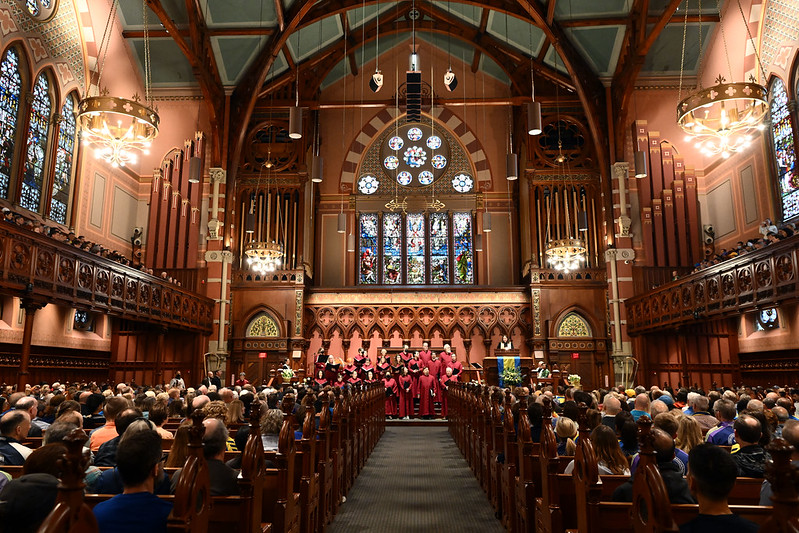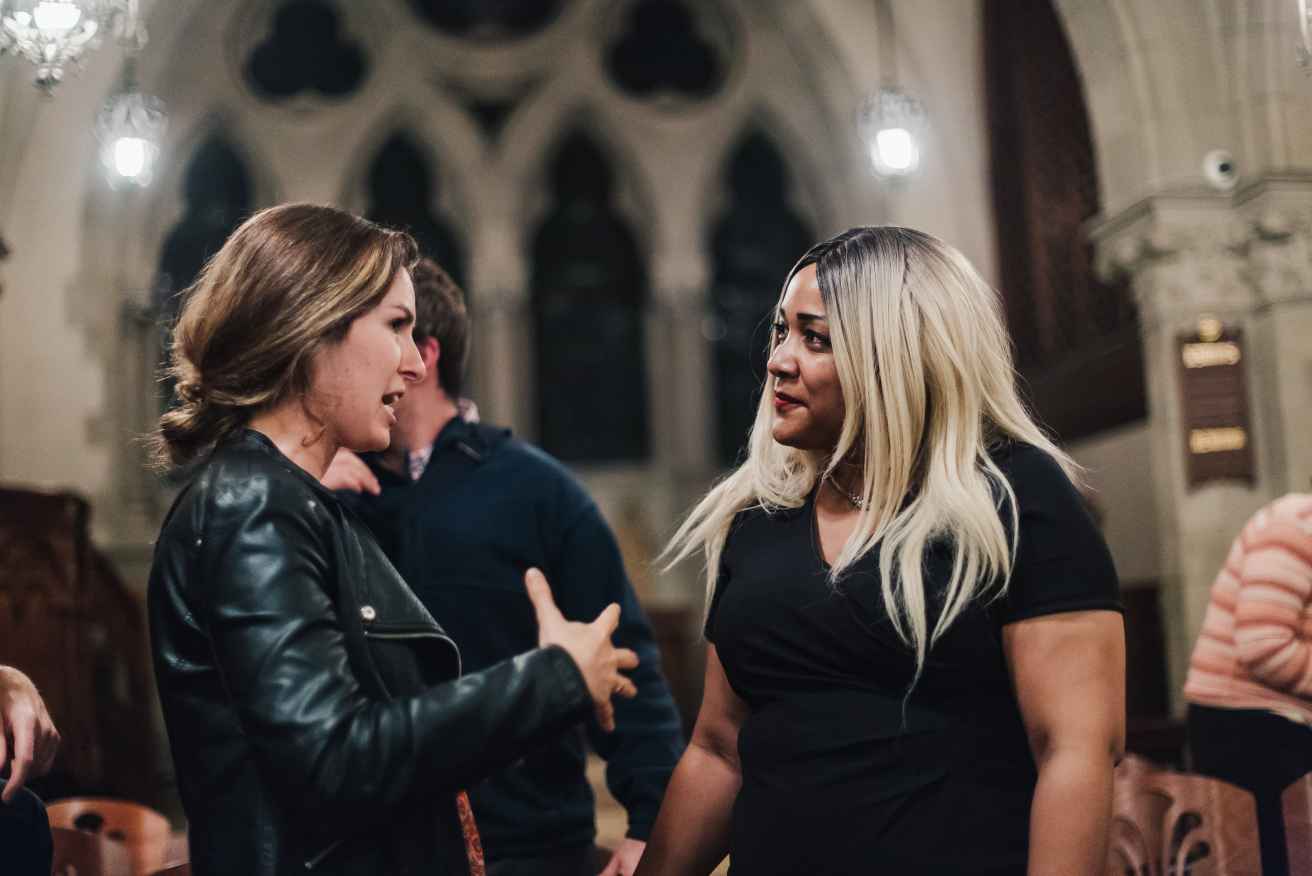Festival Worship - Marathon Sunday
Festival Worship - Marathon Sunday
Embodied
Transcript
I begin with a brief paragraph from a recent article in the Boston Globe:
“They see themselves in the images of Trayvon Martin that stare from television and computer screens. They relate to the sting of being ‘suspicious’ for doing little else than just being themselves and they worry that their accommodations to the fears of others won’t be enough to keep them safe - or alive.”*
Who are they? They are Boston High school students. Trayvon Martin’s murder scares them. Why? “Because”, explains sophomore Jared Brown, “he’s just like us” ... black skin, a teenager, and wearing a hooded sweatshirt. “It could have been any one of us,” says Brown.
You are familiar with the idiom, “Don’t judge a book by its cover.” It is so useful, so familiar, because, of course, we do. We so easily surrender to the temptation to render hasty judgment, to pigeon-hole people, to size them up, to stereo-type others by what we see, to judge each human book by its cover.
It is for this reason that every Thursday evening, here at Old South, at the beginning of our Jazz Worship Service, we bend over backwards to offer a wide, specific welcome to everyone. Week after week, Thursday after Thursday, in our candle-lit, jazz-infused stone chapel, this is what we say:
“Welcome to casual observers and committed Christians. Welcome to believers, questioning believers and disbelievers. Welcome to people of all ages, hues, origins, abilities, and social locations no matter who you love, or what kind of body you have.
We spent considerable time discussing this greeting and, in particular, the final phrase: no matter what kind of body you have. We tweaked it and massaged it, trying to get it right. We may or may not have gotten it right, but this is what we intend by it:
We intend that it communicates an unblinking welcome to persons whose bodies are not likely to make the cover of Vogue, Glamour or Elle; to persons who eat too much and those who eat too little; to persons with disabilities; to transgender persons whose bodies defy conventional definitions of male and female; to persons whose bodies have grown weak and frail and bent with age; to persons whose bodies and whose heads come with and without hair; to persons whose outerwear come in black and brown, red and white and yellow; to persons whose appearance is so different, you do a double-take.
“Welcome … no matter what kind of body you have.”
When we devised this greeting, we were not thinking of Trayvon Martin. Though we might have been.
Nor were we thinking of Marathon athletes. Though we might have been. We were not thinking of the tens of thousands of runners who annually descend upon Boston …a great many of whom are instantly recognizable by their bodies – bodies that cut a strikingly different profile than do many of ours – bodies that are long and lean and exceedingly fit.
There I go again: judging a book by its cover. In fact, among the tens of thousands who will start Monday’s race, there are all kinds of bodies: old ones and young ones, tall ones and short ones, lean ones and generous ones, blind ones and sighted ones, frumpy ones and elegant ones, fleet ones and ponderous ones.
Among tomorrow’s runners will be those whose bodies carry cancer. Among tomorrow’s runners will be veterans whose bodies are missing limbs.
The thing about the Marathon is that it is all about bodies, the human body. The rare beauty of this contest is its bare, spare human simplicity. There are no balls or pucks, sticks or bats, hoops or nets, rackets or pads, helmets or shin guards. Just lungs and legs, muscles and hydration, calories for fuel and heart ... lots of heart.
Among those who manage to propel their bodies all the way from Hopkinton to Boston, some will run, others will wheel, others will do more walking than running. Some will be pushed or pulled, others carried, still others will be guided … and there will be some who will crawl across the finish-line on their knees.
Despite the stereotypes, marathoners are not all possessed of perfect bodies. What marathoners do have in common is an unusually high tolerance for pain. Amen? What marathoners have in common is will-power and grit, tenacity and fortitude. Amen? Also common to marathoners: fetishes with footwear, an addiction to Vaseline and moleskin, and a ravenous interest in complex carbohydrates.
When we devised our greeting—you are welcome here no matter what kind of body you have—we weren’t thinking of the marathon runner nor of Trayvon Martin. We were thinking of Jesus and his body.
The Gospel of John paints an image of an astonishing body. Having suffered beating and crucifixion, death and burial, Jesus appears to his disciples embodied, resurrected and embodied … inhabiting the same body they know and recognize.
But here’s the thing: his resurrected body is damaged. The wounds are still there. There are holes in his hands and a gaping gash in his side.
You might have thought that resurrection would have fixed these things! You might have thought the resurrected body would be perfect: glorious, shining, flawless … blemishes erased, wounds healed and scars eliminated.
You might have imagined that Jesus’ resurrected body would suit the cover of Runner’s World. But that’s not what John tells us. That is not what the disciples experienced.
To the disciple named Thomas, Jesus says: “Put your finger here and see my hands. Reach out your hand and put it in my side.”
Christians hold on to an astonishing claim: that God deigned to put on the self-same flesh we wear … and to experience the limitations of this flesh: pain, hunger, blisters, cramping, dehydration, brokenness, mortality.
And not only that, it looks as if we will carry into eternity all our blemishes and imperfections. Who knew?
But that’s okay … these are, after all, how we know each other … and how we know ourselves.
Today’s text, and the Boston Marathon, and Trayvon Martin’s death all shine a bright light on the human body. We are, after all, embodied.
We can speak of our souls all we want, but it is our physicality, our materiality, our flesh and blood, organs and bones that makes us humanly alive. It is with our bodies that we hold each other, love each other, bear children, and caress loved ones. We can speak of our souls all we want, but God knew what she was doing when she donned flesh and came among us embodied.
The particular, peculiar bodies we each inhabit, the space which our bodies occupy in the world, the way we move, the way we feel … these are as personal and intimate as the skin upon your hand, and color of your skin and the way you are a woman and the way you are a man.
When we devised our welcome—“Welcome … no matter what kind of body you have,” we weren’t thinking of Trayvon Martin ... though we might have been. We weren’t thinking of marathon athletes, though we might have been. We were thinking of Christ ... who came embodied: flesh and blood, organ and bone ... subject to the limitations of this flesh: pain, hunger, blisters, cramping, dehydration, brokenness, mortality.
Welcome to this house and home of God. Welcome, no matter what kind of body you have.
We say this to one another, because we learn this kindness, this compassion, this openness, this generosity of spirit, this honesty, this delight in difference (not from the world, not from contemporary culture, not from TV or Hollywood or Madison Avenue) ... we learn it from God.
We learn it here, in church, with each other, among the members of this broken body of Christ. Here we learn to name and confess our too quick judgments of others by what our eyes see. We learn these practices from our God whose greatest act of compassion was to put on this flesh and wear it … even into eternity.
“Welcome … no matter what kind of body you have.” We can say this to you and to one another because God first said it to us.
____________________
I am indebted in this sermon to theologian and author Nancy L. Eiesland, The Disabled God: Toward a Liberatory Theology of Disability: Abingdon Press, 1994. Eiesland claims that the resurrected Christ – this disabled, embodied God who returns to us complete with wounds – represents “a divine affirmation of the wholeness of non-conventional bodies.” (p.87) “Our bodies participate in the imago Dei,” Eiesland wrote, “not in spite of our impairments and contingencies, but through them (p.101)
* Johnson, Akilah. “Trayvon Martin: ‘He’s just like us’ Killing of black Fla. teen resonates with Boston students.” The Boston Globe [Boston, MA] March 30, 2012.







